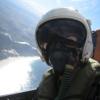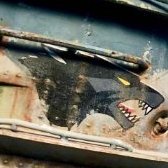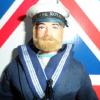-
Posts
191 -
Joined
-
Last visited
Profile Information
-
Gender
Male
-
Location
Cape of Storms
Recent Profile Visitors
2,479 profile views
Rizon's Achievements

New Member (2/9)
673
Reputation
-
I have a wonderfull memory of building this kit. A lot of comments online say a lot of putty is required - with a bit of lateral thinking by fitting extra locating tabs and the like, I built the kit without much putty. The large size of the parts does induce some warping, constraining the parts during assembly sorted out most problems. R
-
Right. I’m going to finish this thread now. Right up to the end these were fighting me. Biggest disaster was that for some reason the paint, specifically the clear coats, refused to cure and remained tacky. Above and beyond the colour coats that already gave me this issue. And this was with two different clear coats; one being a Mr Color and one Tamiya, all with their respective thinners. I was very close to stripping the paint of the MD530F, but in the end I parked the models on the workbench and focussed on my other hobby of painting on canvas. Final task was to add a few aerials to all of them and a sling hook on the MD520N. Then some very light darkening of select panel lines. Otherwise I am going to keep these clean. Fate also interfered royally in the last stages. But guess that is life. Don’t want to sound superstitious, but I hope with me finishing this build the universe will take note and let things calm down a bit. I started with the first steps on the Italeri kit in December 2009 – and the time since then have been the most turbulent in my life. Both good and bad. Anyway, cheers to the completion of my longest build. Here some photos. Might do a RFI when having a bit of time, light and good camera. The three together: Some detail shots: MD 520N MD 530F MD 600N R
- 79 replies
-
- 4
-

-
- MD530F MD520N
- MD600N
-
(and 4 more)
Tagged with:
-
Here is my latest aviation related collection of layers of acrylic paint. “I feel the need, the need to ride that lightning” F-14D of VF 32 “SWORDSMEN” R
- 2 replies
-
- 10
-

-
She most probably departed the world by now. When we got her we estimated her to be 3 years old. And that was 7 years ago. They usually are lucky to make it to 7 years. My inlaws now permanently live on the patch of land we released her on, and they regularly report seeing Chameleons - so we allways hope it is one of her decendants!
- 79 replies
-
- MD530F MD520N
- MD600N
-
(and 4 more)
Tagged with:
-
You gave me an idea there.... I have the ESCI kit (looks like the same mould as yours) in the stash. Was planning on doing it in the version of the actual test flights, but completely forgot about the story in Clancy's book. Nicely executed! 🙂 R
-
Progress. Despite the fight each end every step of the way. Painting is mostly complete for the overall paint work. The decals on the MD 520N have also been applied – these are custom printed decals that are the fine black lines and the blue. The blue sections were printed half transparent, the idea being that it would take on the metallic sheen from the base colour. It actually worked! The metallic sheen on all of the helicopters does unfortunately not show all that well on the photos. But in reality they actually look really sparkling and colourful. The MD 600N: the MD 520N: The MD 530F The next part is obviously finer detail painting, gloss coats and smaller parts that still need adding....
- 79 replies
-
- 3
-

-
- MD530F MD520N
- MD600N
-
(and 4 more)
Tagged with:
-
Definitely involved in a Tango with these three models.... Very much a love / hate relationship – very satisfying to build them, but they seriously are seriously putting up a fight... Back and forth – I complete a step, only for me to have to reverse and try a different path.... Start / stop – life is interfering. Long story. So, what happened. After dusting them lightly with Tamiya white surface primer two things happened: One, the paint refused to cure and remained tacky for weeks. Why I do not know, I tested the thinner / paint combination before hand and it cured rock solid. Such is chemistry I guess. On the MD520N I resorted to stripping the paint off, while for out of desperation I lightly dusted the MD600N and MD530F with Tamiya rattle can surface primer. That kicked the curing process into gear and the paint dried within a matter of hours. The other thing the surface primer taught me was that the intake mesh on the NOTAR fan intakes was too solid once paint was applied. So I re-evaluated and came up with a very fine nylon mesh that gave a much better representation. Was also a bit easier to glue on, as it could be tacked in place with Extra Thin, before little by little using cyno and my trusty magnifiers to permanently bond them in place. Then I started with the masking. For the MD600N I wanted to do a scheme that has a stylised eagle on the rear fuselage. For this I did the necessary artwork on in scale PowerPoint and printed it out in black and white. Then I lay some Tamiya masking tape over the logos and used a sharp blade to cut out the profiles, following the high contrast logo. Helps if one uses magnifying glasses..... The eagle is to be in gold, so I first sprayed a light gold on the required area, before properly positioning the masks. Then I lightly sprayed the model with Humbrol 20 “Crimson” and then a decent coat of Tamiya metallic Mica Red, decanted from the rattle can. This is the result: For the MD520N I needed a sort of white-silver as the base colour. Mixing white to silver in enamels just ends up with a dull grey. So I gave acrylics a try (still something very new to me when it comes to using it for scale models). This works a bit better, and I eventually got something more or less as to what I aimed for. Not without its trial and errors though. And I learned that a cold and wet day, is not a good day to spray acrylics.... The scheme I chose for the MD530F involved masking a number of fine lines. I even learned that i could do this type of fine masking using the built in lamp of my magnifier goggles and an emergency lamp during load-shedding (yes, I live in THAT country). There is a bit of under-spray on the fine lines, but this is not a problem as these will get painted silver and bronze, with the belly remaining white. On all of the models there is of course some cleaning up to do. And then the final detail painting. Also the masking fluid I used on the canopy has dulled the previously applied dark tint. But a final coat of gloss clear should take care of that. I also painted the rotors – these are still in the process of un-masking. Here is the first one though, fitted to the MD600N: R
- 79 replies
-
- 6
-

-
- MD530F MD520N
- MD600N
-
(and 4 more)
Tagged with:
-
A week back I did the masking on the trio. Took a whole weekend, but is is done: And now also completed the last major assembly steps. They are now ready for the paint-shop. I did give them a dusting of white primer to show up faults, and then assembled skids, tail-booms etc. The rotors are just held in place by friction for the photo. I feel decidedly excited – this part of them being in final assembly seemed to bee all too elusive. Remember I started the first one in December 2010, then added the other two and backtracked a bit because of that. By any luck I might get the first proper coats of paint on this long weekend. R
- 79 replies
-
- 9
-

-
- MD530F MD520N
- MD600N
-
(and 4 more)
Tagged with:
-
Slowly getting back to this one.... Currently trying again to spend at least 5 minutes every day doing “some” modelling. Sort of a way to force progress and more importantly to mentally force me to relax. Had all intentions on making major strides on this build during the December holidays. My intention for the (summer) holidays were to stay at home, restore woodwork in the house, complete a commission painting and build models. In other words leave the car in the garage and definitely do not spend any money. A wine tour in the hills behind the house with the wife and my mother was all I was prepared to do outside of my man-cave. But that was not to be. Lets say the holidays ended up with an emergency trip to Namibia (they broke into my mom’s place); while a trip to Namibia is always top of my list of things I love to do (it will always be my home), the circumstance was less than pleasant. But it did not end there, the gearbox of my VW Scirocco ended up having a “few bearings” to be replaced while there, at the cost of ¼ of the cars value. Excluding the plane tickets back to South Africa. To say I am not impressed is an understatement. Anyway, that is my excuse for the no progress. So here is the latest progress. First off was the big challenge of fitting the canopy. Have to admit this was a daunting task of fitting the home made vac-formed parts. I did manage to get the 3 canopies to fit nicely, the problem however was that the all were slightly warped. This necessitated the canopies to be glued in stages. Cyano has the usual dangers of fogging, thus I used to tack it in place at the beginning when ventilation was sufficient. But for the main glue work I used a product called “Gorilla Glue Clear”. This glue is advertised as bonding “anything” – cant vouch for that as it is the first time I used it, but id does glue vac-formed canopies! The glue dries absolutely crystal clear. So much that it is challenging to see if there is a glue join or not. It also has some gap filling properties, which by the nature of home made vac-formed parts is quite handy. The draw-back of the Gorilla Glue is that it takes 2 hours to start setting. That made the time-step gluing of the parts a bit difficult. What I ended up doing was to hold the canopy in place with tape and proceeded to the next section after two hours. A relaxing Sunday was spent doing that, with the time in-between spent in front of my easel. To see how the joint looks when painted I trial-masked the MD530 and gave it a thin coat of white Tamiya primer. The result of the method of gluing is quite acceptable (at least to my eyes – that I hate to admit to my increasing frustration are starting to show signs of ageing.... ). A bit of clean up was required, but all within norms. That done I proceeded to add all the doors of the MD600 in preparation for the first coats of paint. From here the plan is to first spray the canopy and side windows with a darkened clear varnish. Then do the masking, followed by assembling the skids and tail pieces. That way the fragile pieces are protected from the man-handling during the masking process. In theory at least... R
- 79 replies
-
- 6
-

-
- MD530F MD520N
- MD600N
-
(and 4 more)
Tagged with:
-

A pair of Airfix Hawks in 1/72. Finished.
Rizon replied to Fritag's topic in Work in Progress - Aircraft
Maybe also a bit late to the party regarding the decals - I have never managed to get any of the decal solutions (including the "Tamiya Mark Fit Psycho strength") to give any result that water on its own would not give. Regardless of make of decals. Maybe there is a seecret voodoo dance that one has to do that no one dares to mention on the instructions or the web....? Either way, I prefer a 50/50 mix of water and white glue. The slowish drying time of that solution under the decal somehow makes it soft and strechy. I managed to get single decals to conform to very compund curves without effort. Also, the high shrinkage of the glue mix causes the by now soft decal to be pulled into and around any surface detail. Only slight drawback is the cleaning of excess glue afterwards, but that is done quickly with a moistened cloth. My 2c of shared experience. 🙂 -
Small update of a major step. I finally got around to making the grids that cover the intakes of the NOTAR fan. Took a while for me to find a mesh that had a more or less correct sizing. I got this one from the mesh of a coffee plunger that exploded on me. (Talk about a bad start to the day when the coffee plunger explodes first thing in the morning...) The mesh is just put into position on the photos. Still need to figure out how to bond them in place without unintentionally filling in the mesh with glue....
- 79 replies
-
- 9
-

-
- MD530F MD520N
- MD600N
-
(and 4 more)
Tagged with:
-
Greetings to the Garden Route! As for the six-bladed rotor head. I obviously built mine from scratch. Should be easier though in 48. And then there is the 3D printing option (see below). Thanks for the insights! Seems to be quite similar to the 520N in terms of limitations. The calculations I did on the NOTAR / CIRSTEL systems seemed to indicate that the system can be fitted quite comfortably to the smaller helicopters. Was always wondering how far one can scale the thing up. But as you said, if you planing on doing lots of hovering in challenging conditions one is better of with a big tail rotor. The NOTAR is really more ideal for the executive type transport, not for mountain winch rescues... Got a bit side-tracked - was let loose on the companies 3D printer and made one of these: The Creality one we have is not the latest and greatest - but man, what a fun thing to have! Amazing what one can coax out of this with just a bit of planning on how to orientate and support the parts... So, guess my next investment is already decided. Will hang on though till the point when I really need it, the pace at which these improve makes the patience game worth the while. As to the current build - it will remain pure, traditional scratch-building I completed all the rotor assemblies, including the shafts. Something that I insist on with my models is that props and rotors must be able to turn. So I made the shaft assembly so that a metal rod can run inside the kit supplied part and gets fixed to the main rotor. Also on the skids I added a piece of wire where they join the fuselage. A normal but-joint is too weak for my liking, hence the piece of wire that locks the assembly more structurally sound into the fuselage. And this is where I am at. Skids and rotors have only been placed in position for time being: R
- 79 replies
-
- 7
-

-
- MD530F MD520N
- MD600N
-
(and 4 more)
Tagged with:
-
We get asked a lot about the Chameleons and how they express emotions. They are actually very expressive animals, but express themselves in their body language, movement and of course colour of their skin. Very much like an actor in a theater stage production, where facial expression is difficult to convey, they rely on movement and body posture. Really fascinating to see! Regarding you "better and worse" statement - please do tell! Through my research in the post graduate years a read a number of papers and articles on the handling quirks of the MD520N, but never saw anything on the 900 series. Was always wondering how the NOTAR performed on the heavier and more powerful helicopter? R
- 79 replies
-
- 1
-

-
- MD530F MD520N
- MD600N
-
(and 4 more)
Tagged with:





.thumb.jpeg.512869d47e412449d69d30d0295c1ae8.jpeg)


